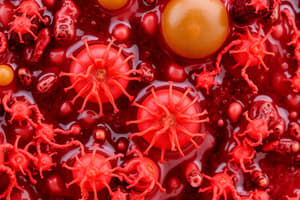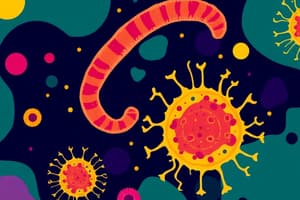Podcast
Questions and Answers
What is the primary function of a Transmission Electron Microscope?
What is the primary function of a Transmission Electron Microscope?
- To bounce electrons off surfaces for imaging
- To penetrate extremely thin surfaces with an electron beam (correct)
- To produce a 3D image of the specimen
- To provide a better resolution than light microscopes only
Which of the following accurately describes the difference between a Scanning Electron Microscope and a Transmission Electron Microscope?
Which of the following accurately describes the difference between a Scanning Electron Microscope and a Transmission Electron Microscope?
- The Scanning Electron Microscope has a greater resolution than the Transmission Electron Microscope.
- The Scanning Electron Microscope cannot produce images of outer surfaces.
- The Scanning Electron Microscope provides a 2D image, while the Transmission Electron Microscope provides a 3D image.
- The Scanning Electron Microscope uses electrons that bounce off surfaces, while the Transmission Electron Microscope uses electrons that penetrate surfaces. (correct)
What defines taxonomy in biological classification?
What defines taxonomy in biological classification?
- A method for categorizing only eukaryotic organisms
- The study of viruses and their impact on ecosystems
- The hierarchical classification system proposed by Carolus Linnaeus (correct)
- A system of naming organisms based on common characteristics
Which of the following characteristics is NOT exhibited by living cells?
Which of the following characteristics is NOT exhibited by living cells?
What method did Carolus Linnaeus develop for naming organisms?
What method did Carolus Linnaeus develop for naming organisms?
Which step involves the release of viral nucleic acid into the host cell's nucleus?
Which step involves the release of viral nucleic acid into the host cell's nucleus?
What is the main consequence of the apoptosis process during viral infection?
What is the main consequence of the apoptosis process during viral infection?
What distinguishes retroviruses from other RNA viruses?
What distinguishes retroviruses from other RNA viruses?
Which method of viral release allows the host cell to remain unharmed?
Which method of viral release allows the host cell to remain unharmed?
In which stage of infection do symptoms of a viral infection typically appear suddenly?
In which stage of infection do symptoms of a viral infection typically appear suddenly?
What happens when a virus remains inactive in a host cell?
What happens when a virus remains inactive in a host cell?
What does the reverse transcriptase enzyme do in retrovirus infection?
What does the reverse transcriptase enzyme do in retrovirus infection?
Which virus is associated with the emergence of shingles after being dormant in the body?
Which virus is associated with the emergence of shingles after being dormant in the body?
What distinguishes eukaryotic microorganisms from prokaryotic ones?
What distinguishes eukaryotic microorganisms from prokaryotic ones?
Which of the following statements about opportunistic pathogens is true?
Which of the following statements about opportunistic pathogens is true?
What is the primary basis of Koch's postulates?
What is the primary basis of Koch's postulates?
What is the main difference between an infectious disease and microbial intoxication?
What is the main difference between an infectious disease and microbial intoxication?
Who is recognized as the 'father of microbiology'?
Who is recognized as the 'father of microbiology'?
What process did Louis Pasteur develop to improve food safety?
What process did Louis Pasteur develop to improve food safety?
Which of the following is NOT a characteristic of acellular infectious agents?
Which of the following is NOT a characteristic of acellular infectious agents?
Which type of microorganism is classified as prokaryotic?
Which type of microorganism is classified as prokaryotic?
Which characteristic is true for prokaryotes?
Which characteristic is true for prokaryotes?
What structure is primarily responsible for protecting bacteria from phagocytosis?
What structure is primarily responsible for protecting bacteria from phagocytosis?
Which component is a primary element of the prokaryotic cell wall?
Which component is a primary element of the prokaryotic cell wall?
What distinguishes Gram-positive bacteria from Gram-negative bacteria?
What distinguishes Gram-positive bacteria from Gram-negative bacteria?
Which structure is not found in prokaryotic cells?
Which structure is not found in prokaryotic cells?
What role do ribosomes play in eukaryotic cells?
What role do ribosomes play in eukaryotic cells?
Which of the following is a characteristic of viruses?
Which of the following is a characteristic of viruses?
What is a common feature of all prokaryotes?
What is a common feature of all prokaryotes?
Which cellular structure aids prokaryotic cells in motility?
Which cellular structure aids prokaryotic cells in motility?
What characterizes the glycocalyx in prokaryotic cells?
What characterizes the glycocalyx in prokaryotic cells?
What do endospores allow prokaryotic cells to do?
What do endospores allow prokaryotic cells to do?
Which viral property describes their inability to replicate independently?
Which viral property describes their inability to replicate independently?
Which of the following is the function of pili in prokaryotic cells?
Which of the following is the function of pili in prokaryotic cells?
Which mechanism do prokaryotes use for asexual reproduction?
Which mechanism do prokaryotes use for asexual reproduction?
What is the primary function of catabolism?
What is the primary function of catabolism?
What can heavy metals do to metabolic enzymes?
What can heavy metals do to metabolic enzymes?
What is the primary function of catabolism?
What is the primary function of catabolism?
What can heavy metals do to metabolic enzymes?
What can heavy metals do to metabolic enzymes?
What is a characteristic of a bacterial genotype?
What is a characteristic of a bacterial genotype?
Flashcards are hidden until you start studying
Study Notes
Microbes and Their Classification
- Microbes are categorized as either cellular (living) or acellular (nonliving).
- Acellular infectious agents include viruses and prions.
- Cellular microorganisms are divided into:
- Eukaryotes: organisms with a true nucleus (e.g., algae, fungi, protozoa).
- Prokaryotes: organisms without a true nucleus (e.g., bacteria, archaea).
Microbial Interaction with Humans
- Most microbes are nonpathogens and are part of the human microbiome, colonizing humans without causing disease.
- Pathogens are microbes that cause disease; opportunistic pathogens only cause disease under certain conditions.
Infectious Disease vs. Microbial Intoxication
- Infectious Disease occurs when a pathogen colonizes the body and causes illness.
- Microbial Intoxication happens when a person ingests a toxin produced by a microbe.
Pioneers in Microbiology
- Anton van Leeuwenhoek: Developed the single lens microscope and is known as the "father of microbiology."
- Louis Pasteur: Created pasteurization and demonstrated the fermentation process and its impact on wine production.
- Robert Koch: Formulated Koch's postulates to establish a causal relationship between microbes and infectious diseases.
Cells and Taxonomy
- Taxonomy is the process of classifying and naming living things; initiated by Carolus Linnaeus's hierarchical system (two kingdoms).
- Cells are the fundamental units of life, exhibiting basic life characteristics: nutrient uptake, energy production, growth, reproduction, stimulus response, and the ability to evolve.
Eukaryotes vs. Prokaryotes
- Eukaryotes possess a true nucleus and membrane-bound organelles, are larger and more complex.
- Prokaryotes lack a true nucleus, have fewer organelles, are smaller, and simpler but fully capable of living and reproducing.
Prokaryotic Cellular Structures
- The cellular membrane controls the movement of substances in and out.
- Cytoplasm is a gelatinous matrix containing organelles.
- Prokaryotic cell walls primarily consist of peptidoglycan and are essential for maintaining cell shape and integrity.
Prokaryotic Glycocalyx and Attachments
- Glycocalyx is a gelatinous coating that protects bacteria from phagocytosis and includes a capsule and slime layer.
- Prokaryotic structures such as flagella, fimbriae, and pili assist in motility and adhesion.
- Spores (endospores) allow bacteria to endure extreme conditions.
Acellular Microbes
- Viruses differ from living cells in five key properties: lack of metabolism, dependence on host for replication, and presence of either DNA or RNA.
- Viral anatomy includes a nucleic acid, capsid, and sometimes an envelope derived from the host cell.
- Viral classification is based on genetic material, presence of a capsule, and host specificity.
Viral Life Cycle
- The viral life cycle consists of attachment, penetration, uncoating, biosynthesis, assembly, and release of new virions.
- Viruses can exit host cells via budding, exocytosis, or apoptosis.
Latent and Retroviral Infections
- Latent viral infections can remain dormant and reactivate under certain conditions.
- Retroviruses integrate their RNA into the host DNA, making the host cell persistently infected.
Fungal Characteristics
- Fungi exist in forms such as molds, dimorphic fungi, and fleshy fungi, with varying pathogenic effects.
- Mycoses (fungal diseases) can affect the skin, bloodstream, and internal organs.
Microbial Physiology and Metabolism
- Microbial physiology focuses on the vital life processes of microbes, including metabolism and nutrient acquisition.
- Metabolism encompasses all biochemical reactions in cells, facilitated by metabolic enzymes.
Genetic Mechanisms in Bacteria
- Bacterial genetics involves heredity, with genotype determining the organism's traits, and phenotype being the expression of those traits.
- Genetic mutations can result in beneficial, harmful, or neutral changes affecting bacterial survival and function.
Genetic Transfer in Bacteria
- Bacteria acquire genetic material through mutation, lysogenic conversion, transduction, transformation, and conjugation (bacterial "sex").
- Genetic engineering enables the transfer of eukaryotic genes for protein production and vaccine development.
Gene Therapy
- Gene therapy aims to introduce normal genes into hosts with mutations, enabling the production of essential gene products to treat diseases.
Studying That Suits You
Use AI to generate personalized quizzes and flashcards to suit your learning preferences.




